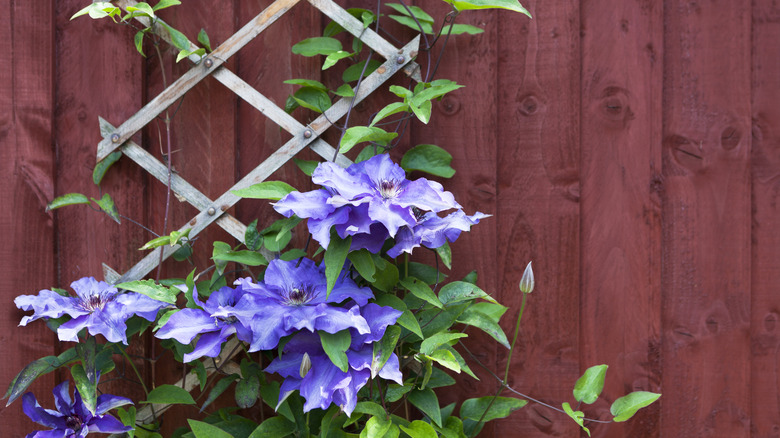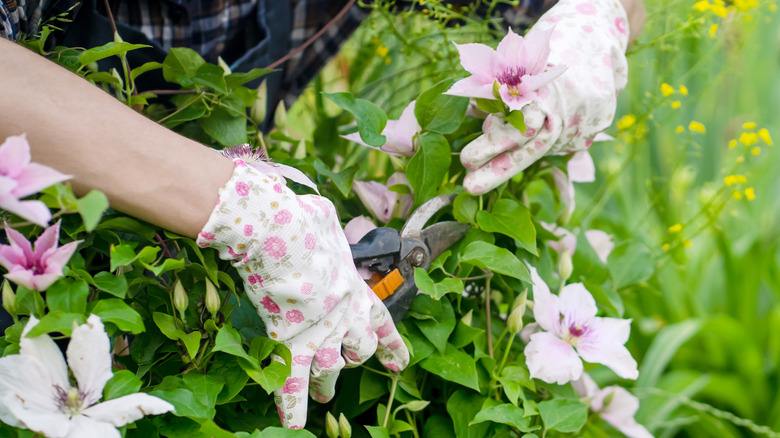Garden Trees, Shrubs & Vines
Erica Crawford
Clematis is a perennial plant from the buttercup family (Ranunculaceae) with more than 200 species and 2,500 cultivars. Often referred to as the queen of climbers, these vines love to wrap around trellises and arbors, slither up walls, and even mingle with other neighboring plants. While beloved for their trailing habit that can reach up to 12 feet long, landscapers are also drawn in by their star-shaped flowers that bloom in various shades of whites, pinks, and purples.
Clematis is native to Asia and North America, making it reasonably easy to grow in the U.S. Plants prefer to be placed in full sunlight and are commonly planted in early spring. It may take a few seasons for this perennial to fully mature, but once it does, you’ll be able to look forward to watching hundreds of buds bloom each year. While clematis is stunning in every area of the garden, it is important to remember that it’s considered an invasive species. If you’re not careful, it will overrun and kill other plants, including trees. For this reason, clematis must be pruned, not only for its own health but also for the health of others. It’s an easy process that requires little effort and is all about timing.
When to prune clematis

Susandaniels/Getty Images
Pruning your clematis will encourage new growth in a plant that reaches extreme lengths and prevent dead and frail stems from overrunning its vines. In many cases, not pruning will deteriorate flowering. To understand when you should be completing your yearly trimming, you must first know which type of clematis you are handling. It should’ve come with a label at the time of purchase, but you can also identify your plant’s type by paying attention to the time of year its flowers typically bloom.
If blooming occurs in winter or spring, you won’t have to prune very often, if ever. With enough space, early bloomers do just fine without the extra care, yet it’s usually necessary if you want to contain them in one area. Common cultivars that bloom in winter and spring include Montana Sunrise, Freda, and Warwickshire Rose. Flowering that happens in early and late summer should be trimmed back in late winter or early spring before they bloom, however, late February is ideal. In many cases, cutting them once more after they’re done for the season, usually in September, will also be beneficial. Some names of those that peak in early summer are Josephine, Star of India, and Andromeda. Late summer bloomers include Ernest Markham, Taiga, and Purpurea Plena Elegans.
How to prune clematis

africa_pink/Shutterstock
While the timing of pruning your clematis will vary based on when it blooms, the process will be very similar across the board. Before the new growth for the season starts to fill in, you’ll want to remove any dead and brittle stemming. If your clematis blooms in February, you can skip step one until after blooming has finished. For early and late summer flowering, you’ll again wait to do any excessive trimming until after the plant has peaked. This will ensure that you do not accidentally remove any buds before the next season.
After your flowers have opened up, cut back your winter/spring and early summer clematis to the new bud or fresh pair of leaves on each lower vine. This will encourage growth in the lower portions of your plant. For the upper half, trim 12 inches above the bud. With a late summer clematis, this process is a little different in that you’ll make a straight cut from the stem to 30 inches above the ground or just above the bud. It is always a bit intimidating to take a pair of shears to our plant babies, but following these steps will make for a healthier growing season.



